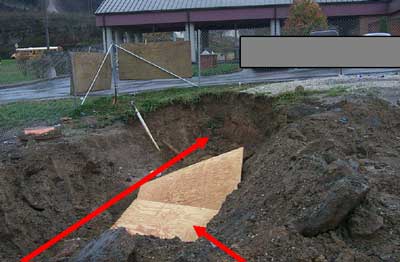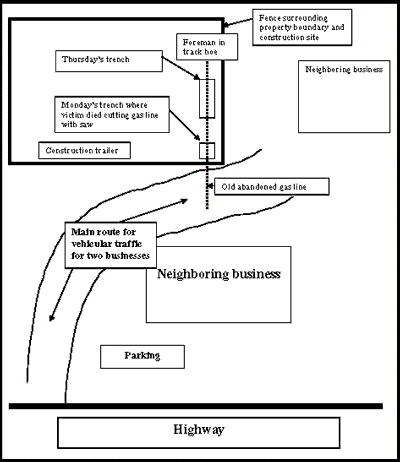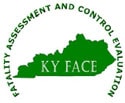38 Year-Old Construction Laborer Dies When Trench Walls Collapse
Kentucky Case Report: 03KY107
Date of Incident: November 3, 2003
Report Release Date: November 5, 2004
Summary
On November 3, 2003, a 38-year-old male construction laborer died when the unprotected 8-foot high walls of the trench he was working in collapsed. The decedent was working for a subcontractor who was contracted by a construction company to remove old gas, storm and sanitary sewer lines and install similar new lines. The old abandoned 6-inch diameter gas line was a high pressure, 300 – 320 psi gas line in 10-inch steel casing and was 600 feet long. There were five employees at the job site employed by the subcontractor; a foreman who was a certified competent person, a lab technician who was a certified competent person, and 3 laborers (one of which was the decedent). The foreman had dug an 8-foot deep trench with a track hoe to expose the abandoned gas line. After the gas line was exposed, the 38-year-old laborer climbed into the trench with a saw to cut through the gas pipe and its casing. The sides of the trench were not shored or benched. As the laborer began sawing, the sides of the trench collapsed, burying him. He was declared dead at the scene by the local coroner.
To prevent further occurrences of a similar occupational fatality, the following recommendations have been made:
- Employers and employees should not take shortcuts.
- Employers should train employees on safe work practices and how to recognize and avoid unsafe work conditions.
- Employers should train employees working in excavations on use of appropriate protective equipment.
Background
On November 3, 2003, a 38-year-old male laborer working for a subcontractor died when the 8- foot unshored walls of a trench he was working in collapsed, burying him. The Kentucky Fatality Assessment Control & Evaluation program became aware of the fatality on November 4, 2003. A site visit was made on November 10, 2003, when interviews were conducted with a representative from the construction company, coroner and local police. Photographs were taken of the scene. The subcontractor chose not to participate in the FACE program. It is unknown what safety training was available for the decedent and if so, whether or not the decedent was trained in trench safety.
A construction company was contracted to build a commercial retail building. It was a multiphase project and the first phase was site preparation for the building, driveway and parking lot. This initial phase included clearing and grading the land and the removal of old gas, water and sanitary sewer lines before installing new utility lines. The construction company contracted specialized subcontractors to fulfill different job requirements of the project. Subcontractors signed a contract with the construction company which outlined job duties and descriptions. Also, subcontractors agreed that work activities would comply with all applicable Occupational Safety and Health Standards.
The construction company employed an on-site job superintendent. Part of his daily responsibilities was to monitor the progress of work activities and ensure that subcontractors were performing per their signed contractual agreements. This included monitoring subcontractors’ compliance with Occupational Safety and Health Standards. Site inspections were conducted by the superintendent three times a day. A daily activities log noting progress, problems and resolutions was maintained by the superintendent in the construction trailer. These notes included subcontractors’ activities such as compliance with Occupational Safety and Health Standards as well as standards violations and the actions taken to correct violations.
Investigation
The job site was in a commercial area located behind and to the left of existing businesses (see Diagram) and was surrounded by chain link fencing. The work was to be performed in a corner where the three properties came together. The two existing businesses shared a driveway which passed from the highway between the business in front and the construction site, around the corner and to the other existing parking lot. Heavy traffic traveled in front of the work site to and from the existing businesses and within 10 feet of the trench where the fatality occurred.
Another subcontractor had a soil technician working on site taking soil samples and performing analysis for soil typing, measuring soil density and soil compaction. Soil samples were taken at different locations around the job site on a routine basis and analyzed. The soil in the area where the trench was located in this fatality had been tested previous to the accident and was analyzed to be type B. Class type B soil is not very cohesive, might have fissures or may be subject to vibration from traffic.
On Thursday (October 30), before the accident, the subcontractor’s crew dug a trench that was inside the fence about 20 feet from the corner shared by the existing businesses. Thursday’s trench was approximately 5 feet deep, 16 feet long, with appropriately compacted and sloped sides. The subcontractor’s crew worked in that trench for 4 days.
The weather during this time period was dry. It had rained 1.15 inches the previous Monday with a scant shower on Tuesday, but had been dry every day since including the day of the incident. Daily temperatures for the week prior ranged from 38°F to 81°F. Temperatures four days prior to the incident ranged from 54°F to 81°F.
On the day of the incident the subcontractor had a five-man work crew excavating the high pressure, 6 inch in diameter 300 – 320 psi gas line that was enclosed in 10 inch steel casing and was 600 feet long. They had previously removed other sections of the gas line by digging trenches with a track hoe and excavating the soil around the pipe/casing assembly. This 16 foot long excavation created an open end and a closed end of the pipe/casing assembly. The open end of the pipe/casing assembly was where the gas pipe was visible and was the end where the gas pipe would be extracted from the casing. For the crew to extract the gas pipe from the casing, the pipe/casing assembly needed to be cut with a saw at the end of the trench. The end of the trench was where the pipe/casing assembly was no longer exposed and continued in a lateral direction into the soil. After extracting the gas pipe from its casing, laborers needed to enter the trench with hand tools and continue to free the casing by hand. When the casing was free from the remainder of the soil it would then be removed from the trench.
On Monday, November 3, 2003, the superintendent conducted the first site inspection from 7:30 am to 8:15 am. The second site inspection was to be at noon with the third inspection later in the day.
At 11:15 am, the superintendent and the subcontractor’s foreman were at the boundary line next to the trench where the work crew had worked in since Thursday. The two men determined the location where the old abandoned gas pipe was to be cut off at the boundary line. After this decision was made, the superintendent returned to the trailer and the foreman proceeded to operate a track hoe and excavate to dig a 6 foot wide x 8 foot deep x 16 foot long trench from the end of Thursday’s trench to within 4 feet of the boundary line and fence. This trench was within 10 feet of the heavily trafficked driveway which served the two neighboring businesses. No sloping or benching methods or shoring equipment were used in the trench. Instead, the sides of the trench, sheared by the teeth of the track hoe, were straight down. After the trench was dug by the foreman, he moved the track hoe to the far end of Thursday’s ditch (see Diagram). The victim jumped in the hole with a saw and proceeded to cut through the gas line and casing (making this cut should have only taken a minute). While the laborer was cutting through the gas line and casing the sides of the trench caved in, burying him.
The soil technician was working across the work site from the trench and saw the laborer enter the trench with the saw. After seeing the laborer enter the trench, the soil technician heard the saw run then stop abruptly. Thinking something had gone wrong in the trench, the soil technician began running toward the trench while yelling for another employee to help. The superintendent was sitting in the trailer with the door open when he noticed the soil technician and another employee of the subcontractor running past the trailer toward the trench. He immediately stepped outside the trailer and ran in the direction the other workers were running. Upon seeing the situation, he immediately (11:34 am) called for emergency services who were stationed across the road from the construction site. They arrived at 11:35 am within one minute of receiving the summons for help. Emergency services arrived, assessed the situation and contacted the coroner. At 11:45 am the coroner arrived and declared the victim dead at the scene.
To prevent future occurrences of similar incidents, the following recommendations have been made:
Back to Top
Recommendations/Discussion
Recommendation No. 1: Employers and employees should not take shortcuts.
According to one person interviewed, the decedent’s job of cutting the exposed gas line pipe and casing with a saw should have only taken a few minutes to accomplish. Taking the time to shore the sides of the trench would have taken longer than sawing the pipe and casing. Instead, it was decided to take a shortcut and not protect the laborer from the possibility of the trench sides collapsing.
Recommendation No. 2: Employers should train employees on safe work practices and how to recognize and avoid unsafe work conditions.
The Occupational Safety and Health Standard 29 CFR 1926.21(b)(2) states the employer is responsible for training each employee on hazard recognition and avoidance thereof. The employees working for this subcontractor were working in trenches 5 feet deep or deeper. It is unknown if the decedent understood the dangers of working in a trench 5 feet deep or more and the importance of taking appropriate safety precautions when working in a trench. Upon interviewing the job superintendent and according to the KY OSH compliance report, the job superintendent documented in his daily log that the subcontractor had not complied with KY OSH standards in another trench on this job site. The situation was addressed with the subcontracting company and thereafter, trenches were properly shored and banked, until the trench was dug and used on Monday.
Recommendation No. 3: Employers should train employees working in excavations on use of appropriate protective equipment.
Employers are required by OSHA Standard 29 CFR 1926.652(a)(1) to protect employees from cave-ins while performing excavation work. This regulation also stipulates configurations for sloping sides of trenches and appropriate materials to be used in shoring walls of excavation sites. Any trench 5 feet or more in depth must have an adequate protection system before being used by employees.
References
- Kentucky FACE Report 03KY072
- CFR 1926.621(b)(2)
- CFR 1926.652(a)(1)
Acknowledgements
Coroner
Construction Company
KY OSH
Local Police Department
Photograph and Diagram

|
 |
| Diagram of construction site and neighboring businesses, driveway and parking lots. |
Kentucky FACE Program
The Kentucky Fatality Assessment & Control Evaluation Program (FACE) is funded by a grant from the Centers for Disease Control and the National Institute of Safety and Health. The purpose of FACE is to aid in the research and prevention of occupational fatalities by evaluating events leading to, during, and after a work related fatality. Recommendations are made to help employers and employees to have a safer work environment.
To contact Kentucky State FACE program personnel regarding State-based FACE reports, please use information listed on the Contact Sheet on the NIOSH FACE web site Please contact In-house FACE program personnel regarding In-house FACE reports and to gain assistance when State-FACE program personnel cannot be reached.

